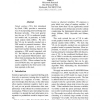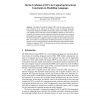1826 search results - page 16 / 366 » Using Random Forests in the Structured Language Model |
ICASSP
2008
IEEE
14 years 3 months ago
2008
IEEE
Bagging is an ensemble method that uses random resampling of a dataset to construct models. In classification scenarios, the random resampling procedure in bagging induces some c...
EMNLP
2009
13 years 6 months ago
2009
Virtual evidence (VE), first introduced by (Pearl, 1988), provides a convenient way of incorporating prior knowledge into Bayesian networks. This work generalizes the use of VE to...
ICASSP
2011
IEEE
13 years 9 days ago
2011
IEEE
This paper introduces a new neural network language model (NNLM) based on word clustering to structure the output vocabulary: Structured Output Layer NNLM. This model is able to h...
JCB
2006
13 years 8 months ago
2006
Protein fold recognition is an important step towards understanding protein three-dimensional structures and their functions. A conditional graphical model, i.e., segmentation con...
BIRTHDAY
2009
Springer
13 years 9 months ago
2009
Springer
Abstract. The Object Constraint Language (OCL) can be used to capture strucnstraints in the context of the abstract syntax of modelling languages (metamodels) defined in the MOF me...


